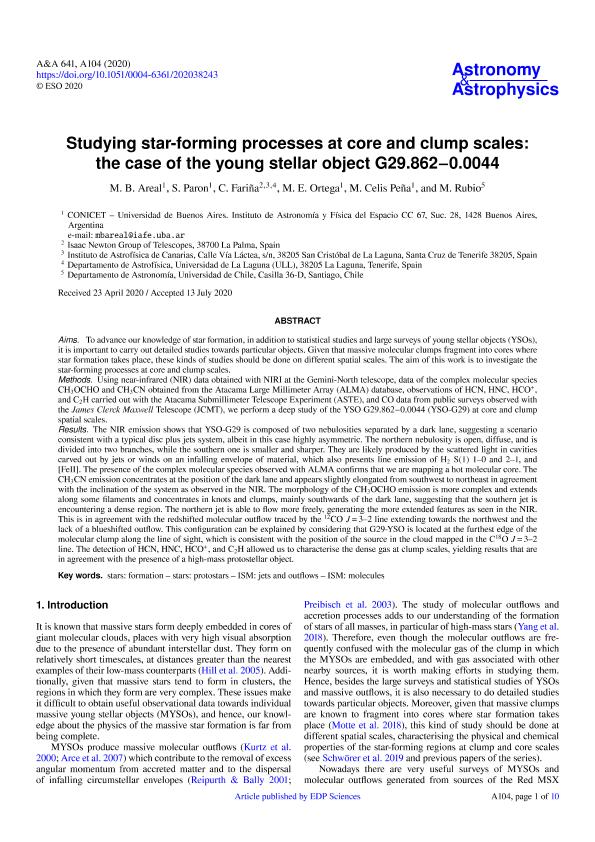Artículo
Studying star-forming processes at core and clump scales: The case of the young stellar object G29.862-0.0044
Areal, María Belén ; Paron, Sergio Ariel
; Paron, Sergio Ariel ; Fariña, Cecilia; Ortega, Martin Eduardo
; Fariña, Cecilia; Ortega, Martin Eduardo ; Celis Peña, Mariela Fernanda
; Celis Peña, Mariela Fernanda ; Rubio, Mónica
; Rubio, Mónica
 ; Paron, Sergio Ariel
; Paron, Sergio Ariel ; Fariña, Cecilia; Ortega, Martin Eduardo
; Fariña, Cecilia; Ortega, Martin Eduardo ; Celis Peña, Mariela Fernanda
; Celis Peña, Mariela Fernanda ; Rubio, Mónica
; Rubio, Mónica
Fecha de publicación:
16/09/2020
Editorial:
EDP Sciences
Revista:
Astronomy and Astrophysics
ISSN:
0004-6361
e-ISSN:
1432-0746
Idioma:
Inglés
Tipo de recurso:
Artículo publicado
Clasificación temática:
Resumen
Aims. To advance our knowledge of star formation, in addition to statistical studies and large surveys of young stellar objects (YSOs), it is important to carry out detailed studies towards particular objects. Given that massive molecular clumps fragment into cores where star formation takes place, these kinds of studies should be done on different spatial scales. The aim of this work is to investigate the star-forming processes at core and clump scales. Methods. Using near-infrared (NIR) data obtained with NIRI at the Gemini-North telescope, data of the complex molecular species CH3OCHO and CH3CN obtained from the Atacama Large Millimeter Array (ALMA) database, observations of HCN, HNC, HCO+, and C2H carried out with the Atacama Submillimeter Telescope Experiment (ASTE), and CO data from public surveys observed with the James Clerck Maxwell Telescope (JCMT), we perform a deep study of the YSO G29.862-0.0044 (YSO-G29) at core and clump spatial scales. Results. The NIR emission shows that YSO-G29 is composed of two nebulosities separated by a dark lane, suggesting a scenario consistent with a typical disc plus jets system, albeit in this case highly asymmetric. The northern nebulosity is open, diffuse, and is divided into two branches, while the southern one is smaller and sharper. They are likely produced by the scattered light in cavities carved out by jets or winds on an infalling envelope of material, which also presents line emission of H2 S(1) 1-0 and 2-1, and [FeII]. The presence of the complex molecular species observed with ALMA confirms that we are mapping a hot molecular core. The CH3CN emission concentrates at the position of the dark lane and appears slightly elongated from southwest to northeast in agreement with the inclination of the system as observed in the NIR. The morphology of the CH3OCHO emission is more complex and extends along some filaments and concentrates in knots and clumps, mainly southwards of the dark lane, suggesting that the southern jet is encountering a dense region. The northern jet is able to flow more freely, generating the more extended features as seen in the NIR. This is in agreement with the redshifted molecular outflow traced by the 12CO J = 3-2 line extending towards the northwest and the lack of a blueshifted outflow. This configuration can be explained by considering that G29-YSO is located at the furthest edge of the molecular clump along the line of sight, which is consistent with the position of the source in the cloud mapped in the C18O J = 3-2 line. The detection of HCN, HNC, HCO+, and C2H allowed us to characterise the dense gas at clump scales, yielding results that are in agreement with the presence of a high-mass protostellar object.
Palabras clave:
ISM: JETS AND OUTFLOWS
,
ISM: MOLECULES
,
STARS: FORMATION
,
STARS: PROTOSTARS
Archivos asociados
Licencia
Identificadores
Colecciones
Articulos(IAFE)
Articulos de INST.DE ASTRONOMIA Y FISICA DEL ESPACIO(I)
Articulos de INST.DE ASTRONOMIA Y FISICA DEL ESPACIO(I)
Citación
Areal, María Belén; Paron, Sergio Ariel; Fariña, Cecilia; Ortega, Martin Eduardo; Celis Peña, Mariela Fernanda; et al.; Studying star-forming processes at core and clump scales: The case of the young stellar object G29.862-0.0044; EDP Sciences; Astronomy and Astrophysics; 641; 16-9-2020; 1-10
Compartir
Altmétricas



